
Sara Kay/Tasting Table
I have a cookbook collection about a mile long, and one of my favorite activities is making new and fun recipes from these books on a regular basis. But, I also have my go-to recipes, the staples in my house, the ones that I barely need to read the recipe for because I know them backwards and forwards. One of my favorites? Roast chicken — simple, classic, and what I turn to when I need something comforting, delicious, and easy to put together. If you’re on the hunt for a solid, top notch roast chicken recipe, it can seem like an endless, forever search. To find a truly solid go-to, I prepared two recipes from two culinary titans who know a thing or two about roasting a chicken: Martha Stewart and Julia Child.
Putting these two recipes against one another was like having a prize fight in my kitchen, with two incredible contenders going head to head in a title bout for roast chicken glory. Martha Stewart’s Perfect Roast Chicken and Julia Child’s Favorite Roast Chicken, are both roast chicken masterclasses, so comparing and contrasting two recipes that are both focused on making the best possible chicken came down to a matter of inches.
To be completely candid, both recipes were, to no one’s surprise, incredible. Both recipes held their own, but after a lot of chopping, trussing, roasting, and basting, and eating what felt like my weight in roast chicken, there was one clear winner. Read on to see which roast chicken recipe reigned supreme, and should become a part of your weekly recipe rotation.
Roast chicken recipes: Martha versus Julia
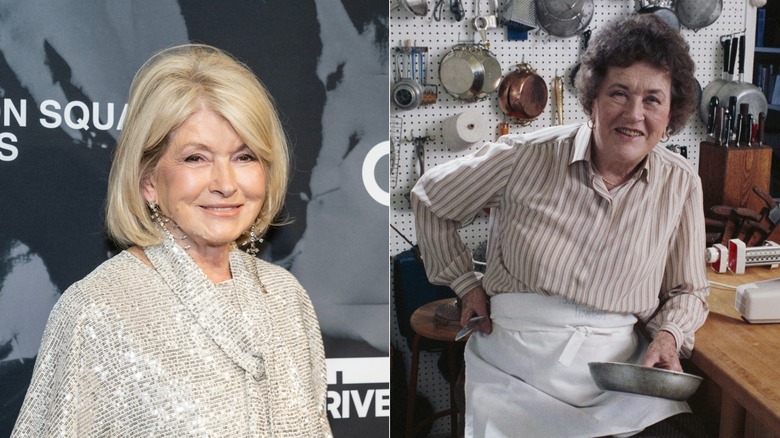
lev radin/Shutterstock & Bettmann/Getty Images
It’s time for a little history lesson, which we’ll follow with a breakdown of each recipe to get a better understanding of just how these two incredible chefs and roast chicken recipes compare to one another. Let’s start with Martha Stewart.
If you’re unfamiliar Martha’s pathway to roasting chicken, here’s the skinny: Martha Stewart’s rise to fame started in 1982 with her first cookbook, “Entertaining by Martha Stewart.” Her Perfect Roast Chicken recipe was first printed in September 1997, in her magazine, Martha Stewart Living, and since then, has remained her go-to recipe for, as the name implies, the perfect roast chicken. It requires just eight ingredients: a whole chicken, butter, salt and pepper, onions, lemons, garlic, fresh thyme, and chicken stock.
For those not up on their Julia Child knowledge, know this: Julia Child is regarded first and foremost for making French cuisine accessible for Americans, and she was one of the first women to host her own television cooking show. Her first book, “Mastering the Art of French Cooking,” was published in 1961 and, along with Simone Beck and Louisette Bertholle, brought French technique to the American audience. Julia Child’s Favorite Roast Chicken was originally published in Food & Wine magazine in January 1997, and uses 13 ingredients, a couple of which are used more than once: butter, carrots, onion, celery, thyme, a whole chicken, salt and pepper, parsley stems, celery leaves, lemon slices, lemon juice, and chicken stock.
How do the ingredients compare?
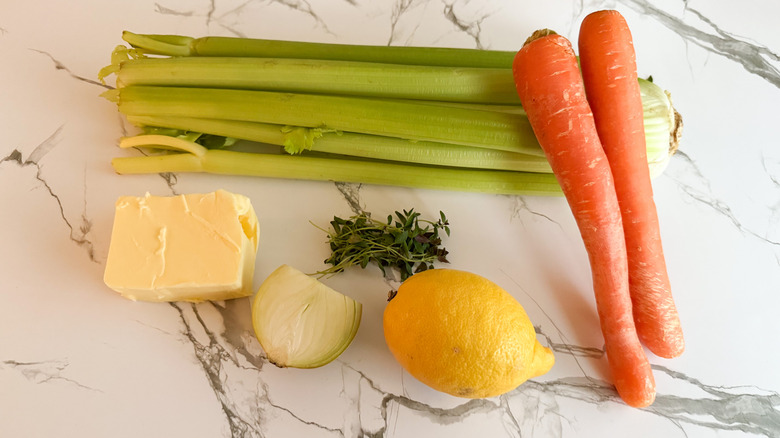
Sara Kay/Tasting Table
Preparing these two roast chicken recipes in a sort of head to head competition was made relatively simple because they both required a lot of the same ingredients. In addition to the chicken, both recipes called for butter, salt and pepper, onions, thyme, lemons, and chicken stock. With the exception of the chickens, each of which cost me about $14, the ingredients for both recipes combined cost about $30. I already had a few components at home, like butter, salt, and pepper, so I didn’t include those in the cost.
The main difference between these two recipes is with the ingredient prep, which was far more detailed for Julia Child’s recipe than for Martha Stewart’s. While Martha’s recipe required some roasting pan preparation and the stuffing and seasoning of the chicken with a few aromatic ingredients, Julia’s included a step of dicing up the carrots, onions, and celery, and sauteeing them in butter and thyme before putting the mixture inside the chicken with some other aromatics. From a timing perspective and not including bringing each chicken to room temperature, Julia’s took about 20 minutes of prep before even getting the chicken in the oven, while Martha’s took about five minutes.
Recipe breakdown: Julia Child’s favorite roast chicken
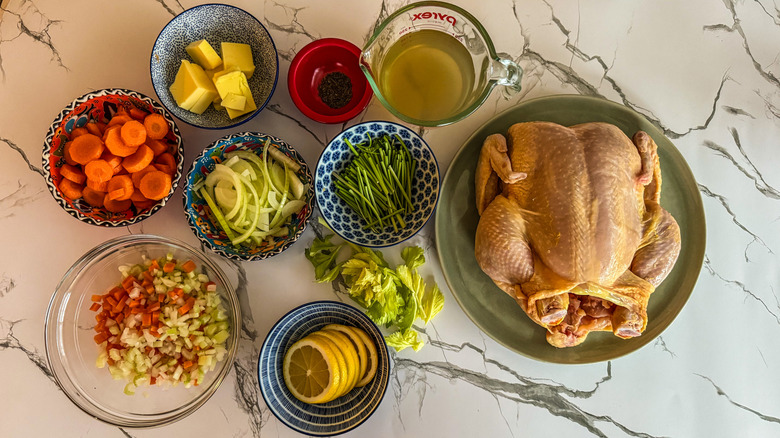
Sara Kay/Tasting Table
In one corner we have Julia Child’s Favorite Roast Chicken. Preheat your oven to 425 degrees Fahrenheit, remove your chicken from the refrigerator, and let it come to room temperature while you prep the ingredients to go inside the cavity. Saute the onions, carrots, and celery in one tablespoon of the butter over moderate heat until softened. Then stir in the herbs and set aside. Season the cavity thoroughly with salt and pepper and add in the cooked veggies, parsley stems, celery leaves, and lemon slices. Massage the entire chicken with one tablespoon of butter, truss the legs, then give the surface of the chicken one more sprinkling of salt.
Place the chicken on a wire rack in the pan, and put into the oven for 15 minutes. Brush with the remaining ½ tablespoon of butter and scatter the sliced onion and carrots in the roasting pan underneath the chicken. Lower the temperature to 350 degrees Fahrenheit, and roast for another 45 minutes. At this point, pour on the lemon juice, and baste the chicken with the pan juices.
After the 45 minutes is up, you can start checking for doneness with a meat thermometer. The chicken is ready when the meat reaches 165 degrees Fahrenheit, the skin is golden brown and the meat is somewhat soft. Let the chicken rest for 10 minutes while you prepare the side sauce. Remove all but one tablespoon of fat from the pan juices, add the stock, and boil for about five minutes or until the liquid has reduced into a thicker, more syrupy sauce. Strain and serve alongside the chicken.
Recipe breakdown: Martha Stewart’s perfect roast chicken

Sara Kay/Tasting Table
And in this corner, we have Martha Stewart’s Perfect Roast Chicken. While your oven preheats to 425 degrees Fahrenheit, let the chicken and one tablespoon of the butter sit at room temperature for 30 minutes. Dry the chicken thoroughly and season the cavity with salt and pepper. Slice your onions crosswise into ½ inch thick slices and place them on the bottom of the roasting pan, acting as a sort of bed for your chicken to lay on while it cooks.
Crush the garlic cloves, pierce the lemon all over with a fork, and insert into the cavity of the chicken with the fresh thyme sprigs. Truss the legs, rub the softened butter all over the chicken, and season with salt and pepper. Place the pan in the oven and roast until the skin is golden brown and the juices run clear. The temperature on a meat thermometer should register 165 degrees Fahrenheit, about 80-90 minutes.
Once the chicken is ready, remove it from the oven and let it rest for 10 to 15 minutes while you prepare the gravy. Pour the pan drippings into a bowl, skim off as much fat as you can, and remove any blackened bits on the bottom of the roasting pan. Pour the drippings back into the pan with the onions and cook over medium-high for about a minute. Add in the chicken stock, turn the heat to high, and cook for another four or five minutes, until the liquid has reduced by about half. Strain into a bowl, remove the onions, and stir in the cold tablespoon of butter until fully incorporated. Carve the chicken as you like, and serve with the gravy on the side.
Julia Child’s roast chicken: the results
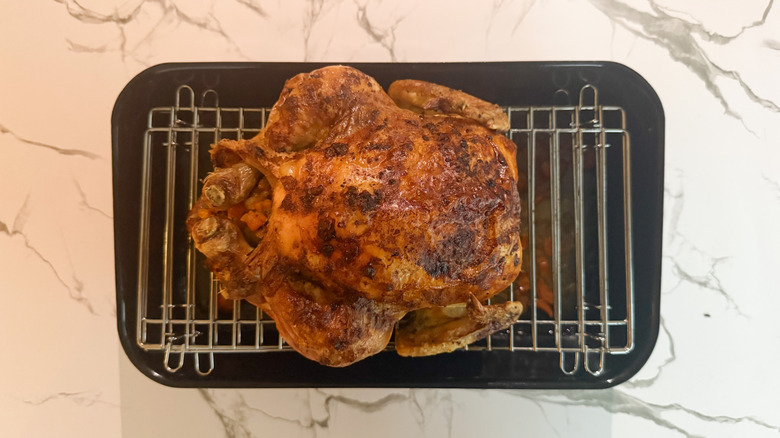
Sara Kay/Tasting Table
Since I live in Sweden and only have one European-sized oven in my kitchen, I wasn’t able to make these chickens at the same time. This did however give me the chance to concentrate on each recipe thoroughly, providing me ample time to understand each one and how each step contributed to the end result. Let’s start with Julia’s recipe.
This recipe requires a lot more prep and attention during the actual cooking process, but for me, the drop in temperature from 425 to 350 was the most crucial. This step made it so the skin could get nice and crisp right up front before letting the meat cook at the lower temperature. The result? A shatteringly crisp skin with a deeply savory flavor. The meat itself was a little juicy and had great flavor from the lemons and thyme, but the white meat, while it tasted great, was bordering on dry. However, the pan sauce really saved the day, giving each bite an extra hit of moisture and flavor. As far as the sauteing of the vegetables beforehand, I personally didn’t find that to make a huge difference when it came to the flavor of the meat.
Martha Stewart’s roast chicken: the results
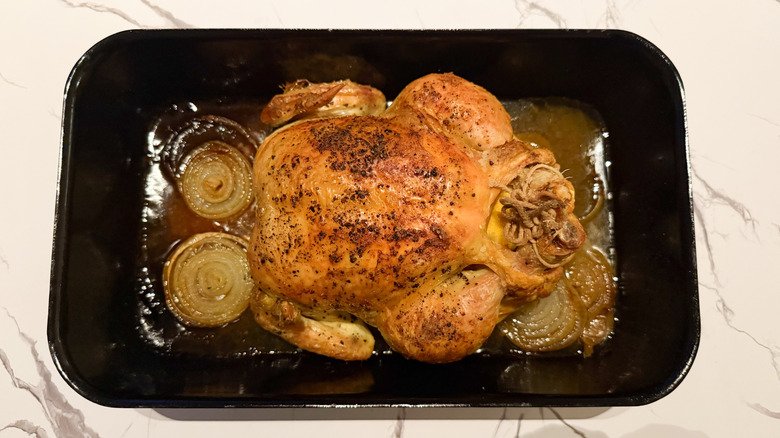
Sara Kay/Tasting Table
Martha’s recipe, unlike Julia’s, had a lot less prep work and was for the most part, a much more straight forward recipe to follow. Other than about 30 seconds of prep for the cavity ingredients, some buttering and seasoning of the skin, and preparing the roasting pan accordingly, this recipe was fairly stress-free, a characteristic I am always looking for in a go-to weeknight recipe.
After about 80 minutes in the oven and another 15 minutes of rest, the skin was golden brown and crunchy, and the meat was tender and juicy and loaded with lemony, herbaceous flavor — even that stubborn breast meat. The gravy, however, is the real star here. Flavored intensely throughout the cooking process with the butter and seasoning from the skin and the onions in the pan, the monter au beurre (adding cold butter to the sauce) step at the end made the gravy silky smooth and unctuous, the perfect accompaniment for the chicken. Each bite made me more excited for the next one.
The winner: Martha’s roast chicken should be your go-to

Sara Kay/Tasting Table
Deciding which chicken should be the go-to was a difficult choice for me. I have such deep, profound respect for these women, these pioneers of the cooking industry, and both recipes have such high highs to them. Both recipes also prove that butter is absolutely a necessary step if you want that extra crispy skin. The skin on Julia’s recipe was unmatched, but the flavor and texture of the meat on Martha’s was far more enjoyable. In the end, Martha’s recipe resulted in a chicken that I would make over and over again.
Not only is the ingredient list for Martha’s roast chicken a short one with majority pantry ingredients, the recipe itself is more or less full-proof. With Julia’s recipe, I found the procedure a bit confusing, since the way it’s written makes it seem like you should be roasting the chicken for 15 minutes, then 45 minutes, then another hour. In reality, it’s just that first 15 minutes and then the additional 45, after which you can start checking for doneness and letting it cook an additional few minutes until it reaches the right temperature.
While the skin on Julia’s chicken was outstanding, the meat on Martha’s was absolutely perfect, and when you add in the onion gravy, it really was the knockout punch. For those searching for a weeknight roast chicken that will deliver delicious results every time, Martha Stewart’s recipe is the right choice.
Methodology
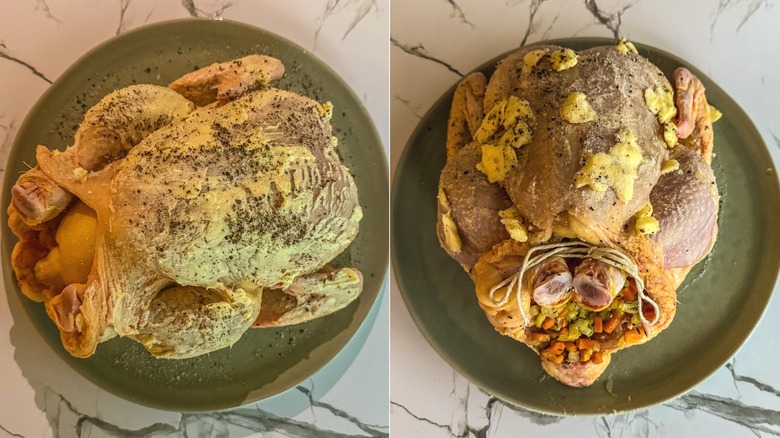
Sara Kay/Tasting Table
I have classic French culinary training from the French Culinary Institute, so I feel pretty good about my skills in the kitchen. However, thanks to weekly Shabbat dinners in my household growing up, roast chicken has been a staple in my diet since before I can even remember, so to say I felt confident I could do both recipes justice is a bit of an understatement.
To do the best possible comparison of these two recipes, I studied each recipe thoroughly and made sure I understood each procedure inside and out before starting. I purchased all of the ingredients from the same grocery store, measured out each ingredient to the exact specifications, and made both chickens on the same day. I tried the skin, the white meat, and the dark meat on their own and judged each based on flavor and texture before dunking the meat into any of the gravies. I also got a second opinion on each chicken, letting my husband try each one without telling him which recipe was which. Since this roast chicken is meant to be a go-to recipe that doesn’t require a whole lot of guess work, I factored prep time, number of ingredients, and procedure heavily into my judgment of each.

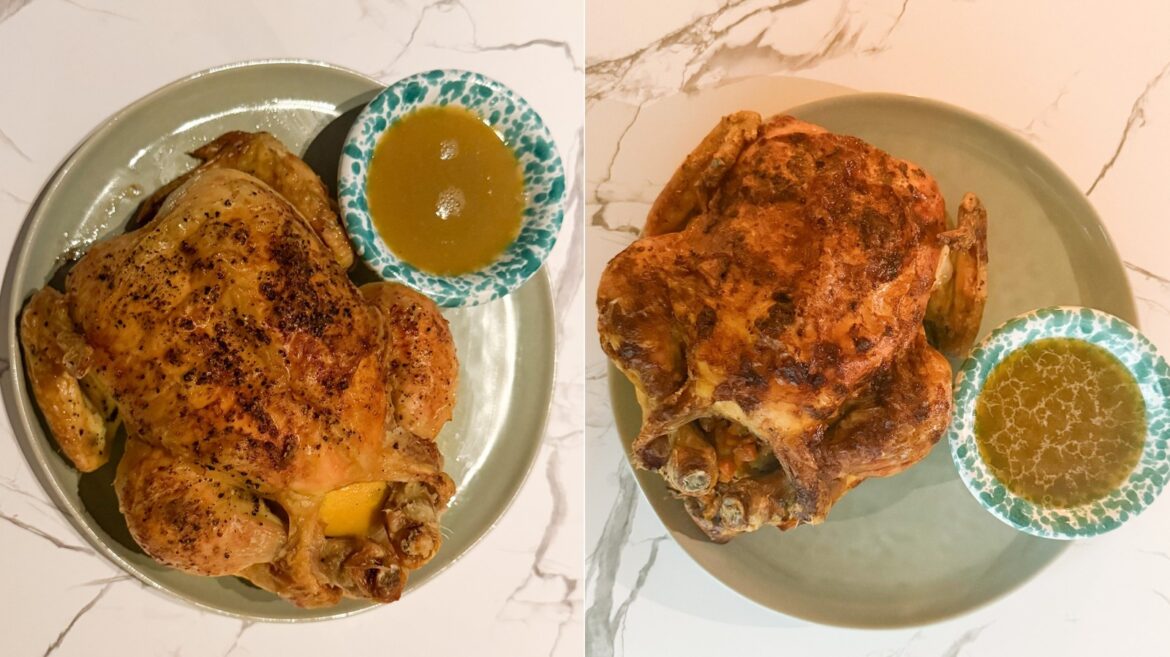
Dining and Cooking